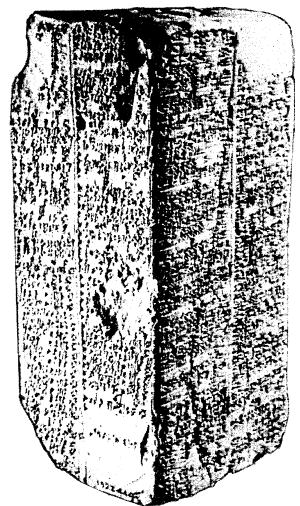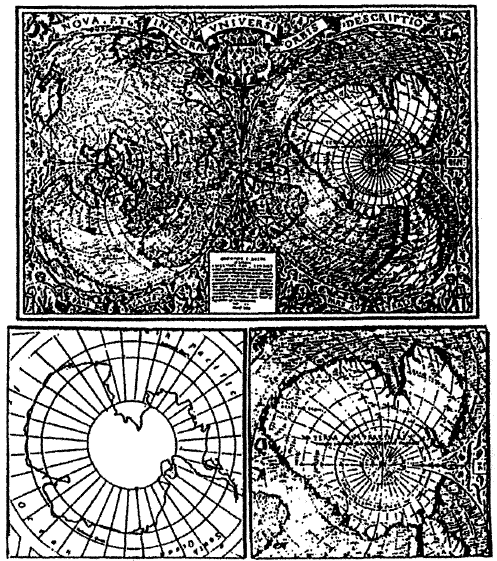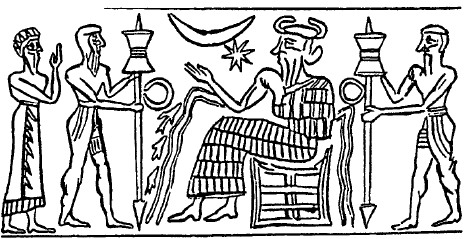|
The Sumerians denoted these elements of advanced knowledge and the sum total of civilization in the term Nam.lugal.la, a term usually translated ‘Kingship’. And Kingship, the Sumerians asserted, was brought down to Earth from the heavens.
In Egypt, as we have seen, they were arranged by dynasties; in Babylonia and Assyria, in Elam and Hatti and Persia and beyond - and in the Bible with its two Books of Kings - the King Lists named successive rulers, giving their lengths of reign and occasionally a brief biographical note. In Sumer, where kings ruled in numerous city-states, the main list was arranged by the royal cities that served as the land’s central or ‘national’ capital at any given time - a function that rotated from one major city to another.
And Sumer’s most famous and best preserved King List begins with the statement "When Kingship was brought down from Heaven" - a statement that matches the opening verses of the tale of the pre-Diluvial Cities of the Gods, that we have just quoted:
Those assertions, it should be clear, were not meant just to enshrine Kingship with divine status; a fundamental tenet of Sumerian history and teachings was that Kingship was actually, and not just figuratively, brought down to Earth from the heavens - that the Anunnaki (= ‘Those who from Heaven to Earth came’) actually began their civilized presence on Earth in five settlements, as stated in tablet CBS-10673.
Though the name of the god who made the grants is missing in that tablet, one can say with certainty that it was Enlil, who followed Enki in coming to Earth - a detail recognized by the statement that,
Furthermore, each one of the others who were granted a city - Nugig J= the Moon god Nannar/Sin), Pabilsag (= Ninurta), Utu (= Shamash), and Sud (= ‘The Medic’, Ninmah) - was not just a high-ranking member of the Sumerian pantheon, but was related to Enlil. It was after Enlil’s arrival that Enki’s initial outpost (Eridu) was expanded to five (then eight) full-fledged settlements.
Two of the key documents can be seen by anyone who visits the Ashmolean Museum of Art and Archaeology in Oxford, England - a museum that traces its beginning to the donation, in 1683, by Elias Ashmole, of twelve cartloads of antiquarian collectibles that the official history of the Museum describes as "a Noahs ark of rarities."
The original collection diversified and grew over the centuries to become an official institution of the University of Oxford. Throngs do not wait in line to enter it; it has no Mona Lisa to attract multitudes or moviemakers. But among the objects it houses are two pricesless archaeological finds of utmost importance to the history of Mankind and our planet; and both record the Deluge, alias "Noah’s Flood."
They, or copies of them, in all probability served as a
source for the writings of Berossus.
WB-444 is the better known of the two, for while WB-62 looks like the ‘usual’ kind of clay tablet, WB-444 is a rare, remarkable and beautiful four-sided prism of baked clay (Fig. 42).
Fig. 42
Known as The Sumerian King List, it details how Sumer’s capital was first in the city of Kish, then moved to Uruk and to Ur, changed to Awan, returned to Kish, transferred to Hamazi, returned to Uruk and then to Ur, and so on, ending in the city called Isin. (The last entry dates the document to a king named Utu-Hegal, who reigned in Uruk circa 2120 B.C. - more than 4,100 years ago.)
This is what it says:
And, continued in translation only:
This usual rendering of WB-444’s first lines is misleading in one key respect: In the original clay document, the numbers of the lengths of reign are given in Sar units (using the numeral sign for ‘3,600’):
The Sar units in this prism are the very Saros of Berossus.
Significantly, the Sar unit of reign applied only to the pre- Diluvial rulers in the Cities of the Gods; the unit of count changes to regular numbers in the post-Diluvial part of the document.
Embracing the cities and reigns from the start in Eridu to the deluvial finale in Shuruppak, its list ends with Ubar-Tutu and not with Ziusudra; but as tablet XI of the Epic of Gilgamesh clearly stated, the hero of the Deluge, Utnapishtim/Ziusudra, was the last ruler of Shuruppak, and he was the son and successor of Ubar-Tutu.
One such little-known tablet is kept in a private collection in the Karpeles Manuscript Library Museum in Santa Barbara, California. It too names 8 kings in 5 cities, but its different reign lengths add up to "10 great Sars + 1 Sar + 600 x 5," which equals only 222,600 years.
Called by some scholars The Dynastic Chronicle, it lists 9 kings in the first five cities, again with somewhat different Sar numbers - Alulim 10 (= 36,000), Alalgar 3 (= 10,800) instead of 28,800, and so on - but correctly ending with two kings in Shuruppak:
This tablet adds after the total of "5 cities, 9 kings, 98 Sars" (= 352,800 years) a brief explanations for the Deluge: "Enlil took a dislike to mankind; the clamor they made kept him sleepless" ...
A comparison of WB-62 with the Greek fragments of Berossus (converting Sars/Saros to numbers of years) points strongly to this version as his principal source:
Which of the various tablets that we have reviewed is the most accurate?
The one that ends in Shuruppak and includes Ziusudra and his father/predecessor is plausibly the most reliable; with them, the list has ten pre-Diluvial rulers in six Cities of the Gods.
The Bible too lists ten pre-Diluvial Patriarchs; though all were descendants of Adam through his grandson Enosh (Hebrew for ‘Human’) and not considered gods, the fact that they numbered ten and that the hero of the Deluge, Noah, was - like Ziusudra - the tenth, adds support to the Ten Rulers count as the correct one.
Assuming that Berossus had reported the most reliable version, we also end up with his total of 120 Sars (= 432,000 years) as the correct combined total of the pre-Diluvial reigns - the time that had passed from when "kingship was brought down from heaven" until the Deluge. Thus, if we could determine when the Deluge had occurred, we would obtain the date when the Anunnaki had arrived on Earth.
The usual explanation, that it represents a limit on human longevity set by God at the time of the Deluge, is a dubious explanation in view of the fact that the Bible itself reports right thereafter that Shem, the eldest son of Noah, lived after the Deluge to the age of 600 years, his son Arpakhshad to 438, then Shelach to 433 years, and so on in descending longevities to 205 years for Terah, the father of Abraham; and Abraham himself lived to age 175.
Moreover, a careful reading of the Hebrew shows that Genesis 6:3 states "and his years were one hundred and twenty." "Were" (not "will be"); and "his" can be understood as referring to the deity’s count (in Sar years!) of his own presence on Earth from Arrival to Deluge.
In earthly years, that would be 432,000 (120 x 3,600) - a statement matching the ten-kings/120-Sars of Berossus and the Sumerian King List.
It forms, for example, the core of Hindu traditions about the Ages (‘Yugas’) of Earth, Mankind, and the gods: A Caturyuga (‘Great Yuga’) of 4,320,000 years was divided into four Yugas whose diminishing lengths were expressions of 432,000 years - the Golden ‘Fourfold Age’ (432,000 x 4), the Threefold Age of Knowledge (432,000 x 3), the Twofold Age of Sacrifice (432,000 x 2), and finally our present era, the Age of Discord (432,000 x 1).
According to the Egyptian priest Manetho, the "duration of the world" was 2,160,000 years; that equals five eras of 432,000, or 500 Sar years (3,600 x 500 = 2,160,000).
In Hamlet’s Mill (1977), Professors Giorgio de Santillana and Hertha von Dechend cite additional instances of 432,000 serving as,
The elimination of that ‘ice box’, I have suggested, caused the abrupt end of the last Ice Age circa 13,000 years ago.
The studies confirmed both the abruptness and timing - about 13,000 years ago - of the Ice Age’s ending in Antarctica, but left unexplained the reason for the phenomenon.
Additional recent studies support those conclusions: A
study of ancient temperatures (Nature, 26 February 2009) determined
that while warming at the end of the last Ice Age was relatively
gradual in Greenland (north Atlantic), it was "rapid and abrupt" in
Antarctica (south Atlantic) about 13,000 years ago.
A diagram accompanying the article shows the area of maximal tidal impact stretching from the Persian Gulf to the Mediterranean Sea and northeast therefrom - the very Lands of the Bible, all the way to Mount Ararat.
The name, E.ri.du, literally meant ‘House in the Faraway Built’; it is a word that has taken root in many languages throughout the ages to denote Earth itself: Earth is called Erie in German (from Erda in Old High German), fordh in Icelandic, ford in Danish, Airtha in Gothic, Erthe in Middle English. It was called Ereds in Aramaic, Ertz in Kurdish - and, to this day, Eretz in Hebrew.
All the lists agree that Alulim and Alalgar were the first rulers in the first city, Eridu; but as is clearly stated in tablet CBS-10673, Eridu was forever granted to Nudimmud - an epithet of Ea/Enki that meant ‘He Who Fashions Artifacts’; it remained his ‘cult center’ forever, no matter who was the Chief Administrator ("king") there.
Likewise, Sippar forever remained the ‘cult center’ of the god Utu, better known by his Akkadian name Shamash; Shuruppak was always linked to the Sud - ‘Medic’ - Ninharsag; and so on.
Their leader, all the texts agree, was E.A - ‘Whose abode is water’, the prototype Aquarius. ‘Oannes’ had arrived on Earth.
The long text (restored from tablets and fragments scattered between two museums) includes the following first-person statements by him:
One of the first tasks was to establish a command post, a headquarters house; it was built at the edge of reed-growing marshes:
Some of the oldest cylinder seals, illustrating Sumer’s earliest times, depict reed huts of the kind that the Anunnaki could have erected from the readily available reeds at the edge of the marshes; they all depict inexplicable antenna-like devices protruding from the roofs of those reed huts (Fig. 44).
Enki, the text continues, then gathered his lieutenants at his command post.
They included "The weapons-carrying the "Chief-pilots," the "Chief of supplies," the "Lady of grinding and milling," and "the [... ] who purifies the water." Besides shelter, nourishment had to be found, and the marshes offered an ample fresh supply:
Subsequent sections of the text, written in the third person, record Enki’s orders to his lieutenants:
Enki himself is credited with waterworks affecting the two rivers, and other lieutenants are named for water- related tasks:
But breaks in the tablets or use of undeciphered terminology leave the nature of some water-related operations uncertain; these include a seawater assignment to a female lieutenant whose epithet-name, Nin.Sirara (= ‘Lady of Bright Metal’), suggests duties linked to precious metals.
Nim.gir.sig, meant "Chief Determinator of Luster." Depictions on early cylinder seals (Fig. 45) show Enki in a reed boat, navigated among the reeds, with a lieutenant-god holding a rodlike device.
The boat is equipped at
both ends with poles to which are attached circular devices, akin to
those placed atop the reed huts. What do all these tidbits of information mean?
Figure 45
In such circumstances, the visit to our planet would have been a one-time event.
But the overwhelming ancient evidence indicates that the "visit" lasted an incredibly long time, that it entailed permanent settlements, that the Anunnaki kept coming and going, and that even when a calamity - the Deluge - destroyed all, they stayed on and started all over.
This is a pattern of a planned colonization - for a purpose.
In that second phase of the Anunnaki’s activities on Earth, other gods arrived; leading them was En.lil (= ‘Lord of the Command’) for whom a new city of the gods, Nippur, was established; its heart was a command and communications hub where orbit-controlling "Tablets of Destinies" spun and hummed in the Dur.an.ki, the ‘Bond Heaven-Earth’ Holy of Holies.
The Abzu, according to all relevant Sumerian texts, was located in a distant region called A.ra.li (= ‘The place of the shining lodes by the waters’) in the "Lower World"; it is a geographic term that applied - in varied texts, including some dealing with the Deluge - to southern Africa. Arali, I wrote, was in southeastern Africa - a gold-mining region to this day.
It also involved a change in mission policies, a change of commanders, and the unintended transfer to Earth of personal rivalries and clan clashes from the Anunnaki’s home planet, Nibiru, to planet Earth. Varied texts, among them the Atra-Hasis Epic, detail the tale of the ensuing events; they were, as we shall see, the forerunners to the Creation of Man, the explanation for the circumstances of the Deluge, and the key to unlocking the enigmas of the demigods.
We have to read, re-read, and understand the Mesopotamian Enuma elish and the biblical tale of Genesis.
The precise information they provide not only explains many of the phenomena in our Solar System and beyond - it sheds light,
ABODE OF GOLD AND FLOWING WATERS
Its Arali, its mining zone, was reported in one text to have been "120 beru of waters away from the quay on the Euphrates" - a distance of traveling 120 "double hours" - ten days of traveling by sea. The mined ores were transported to the Edin by cargo ships called Magur Urnu Abzu (= ‘ship for ore of Lower World’), for smelting, refining, and formation into portable ingots called Zag (= ‘Purified Precious’).
Sumerian-Akkadian syllabaries stated that "Abzu = Nikbu" - a deep
and tunneled mine. The initial pictogram for Abzu (from which its
cuneiform sign evolved) represented a mining shaft - variants of
which stood for gold and other mined minerals, including precious
stones:
Later Assyrian inscriptions identified Meluhha as Kush, "land of the dark- skinned people" (= Ethiopia/Nubia).
The syllabic components of the Sumerian term convey the meaning ‘Fish-filled Waters’; the term may thus explain cylinder seal depictions of fish-filled waters flowing from Enki, who is flanked by workers holding typical gold ingots:
|





